Application of the SUSTAIN Model to a Watershed-Scale Case for Water Quality Management
Abstract
:1. Introduction
2. Materials and Methods
2.1. Brief Description of SUSTAIN Model
2.2. Study Area
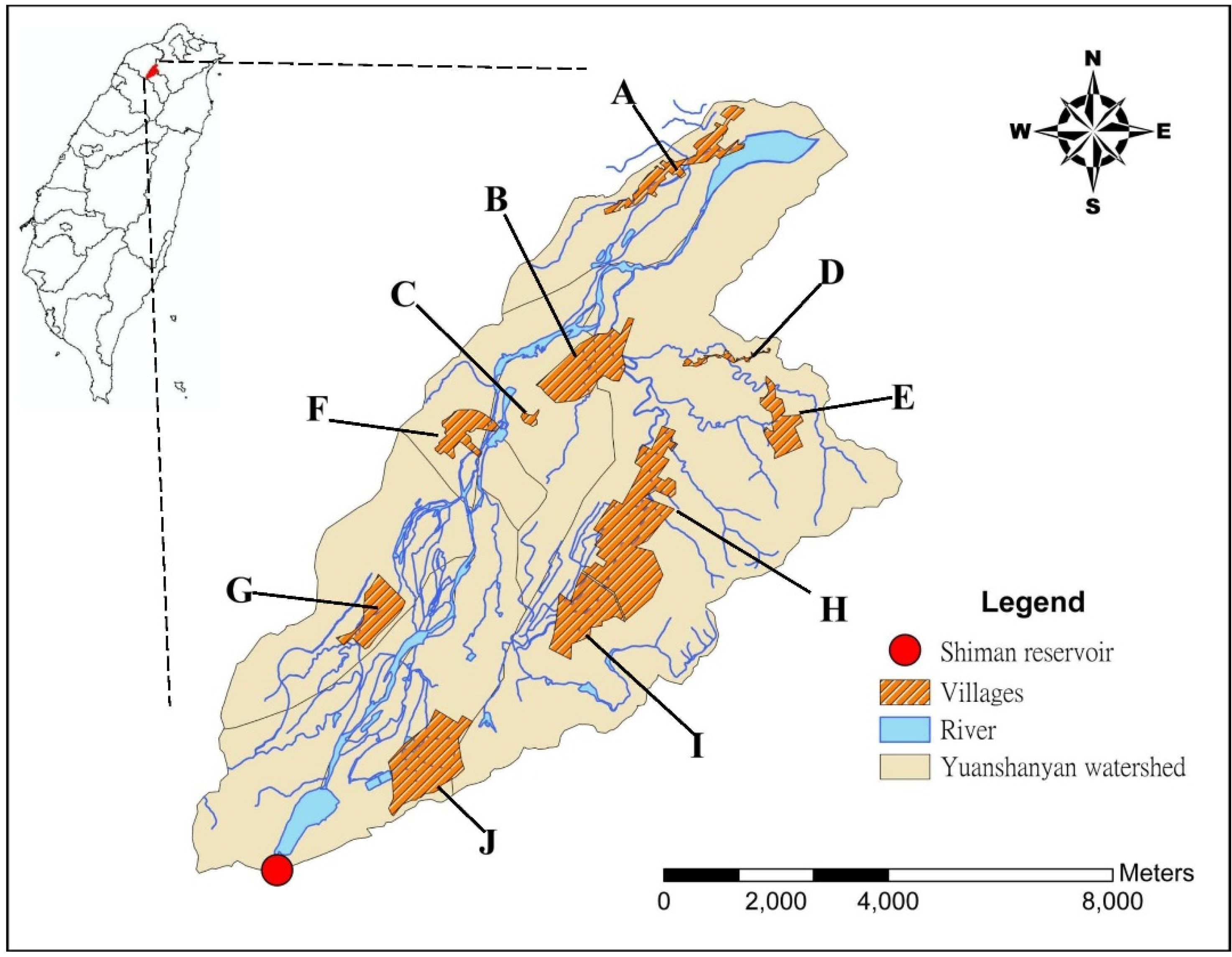
2.3. Model Simulation Process
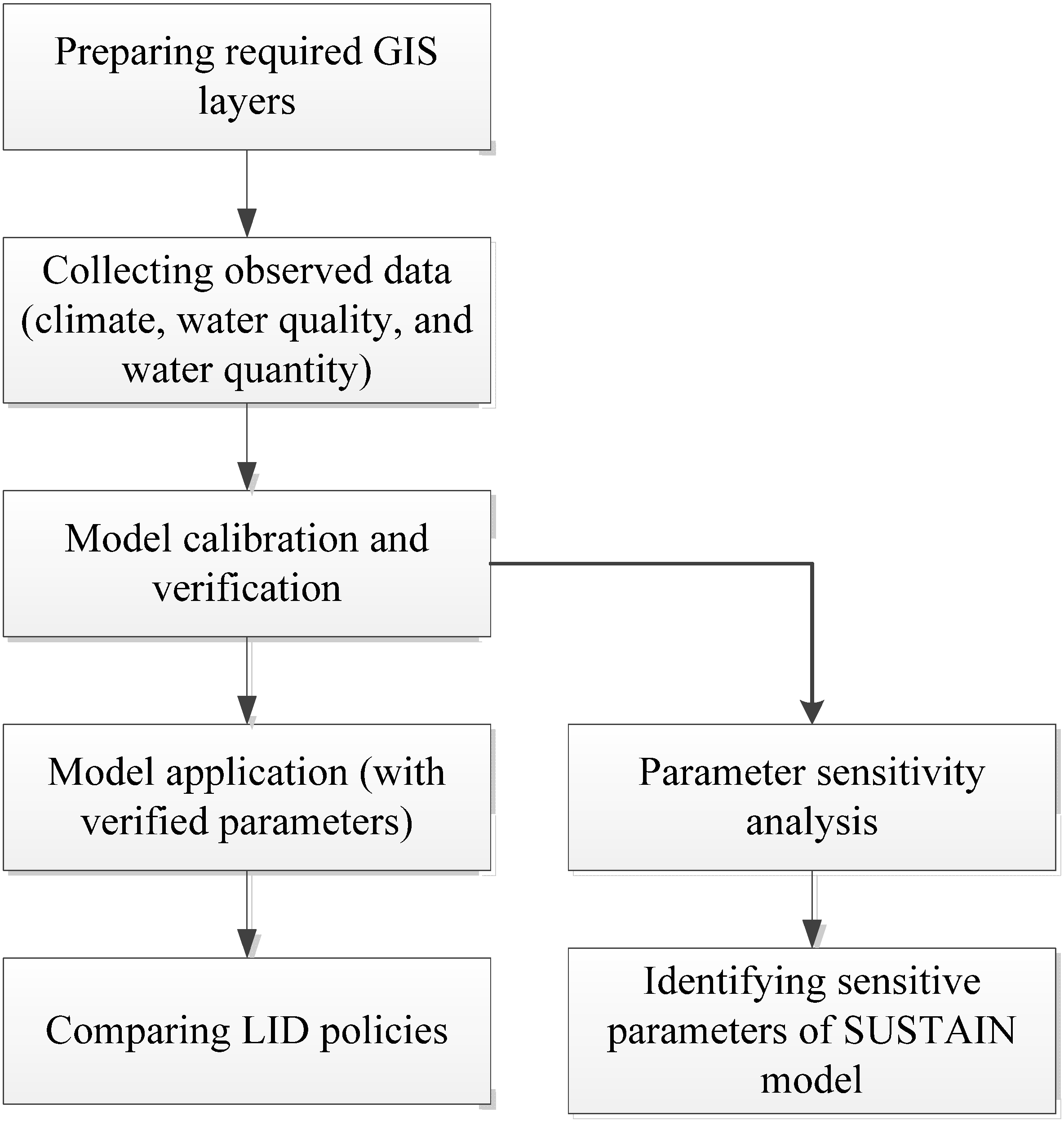

3. Results and Discussion
3.1. Model Calibration and Verification
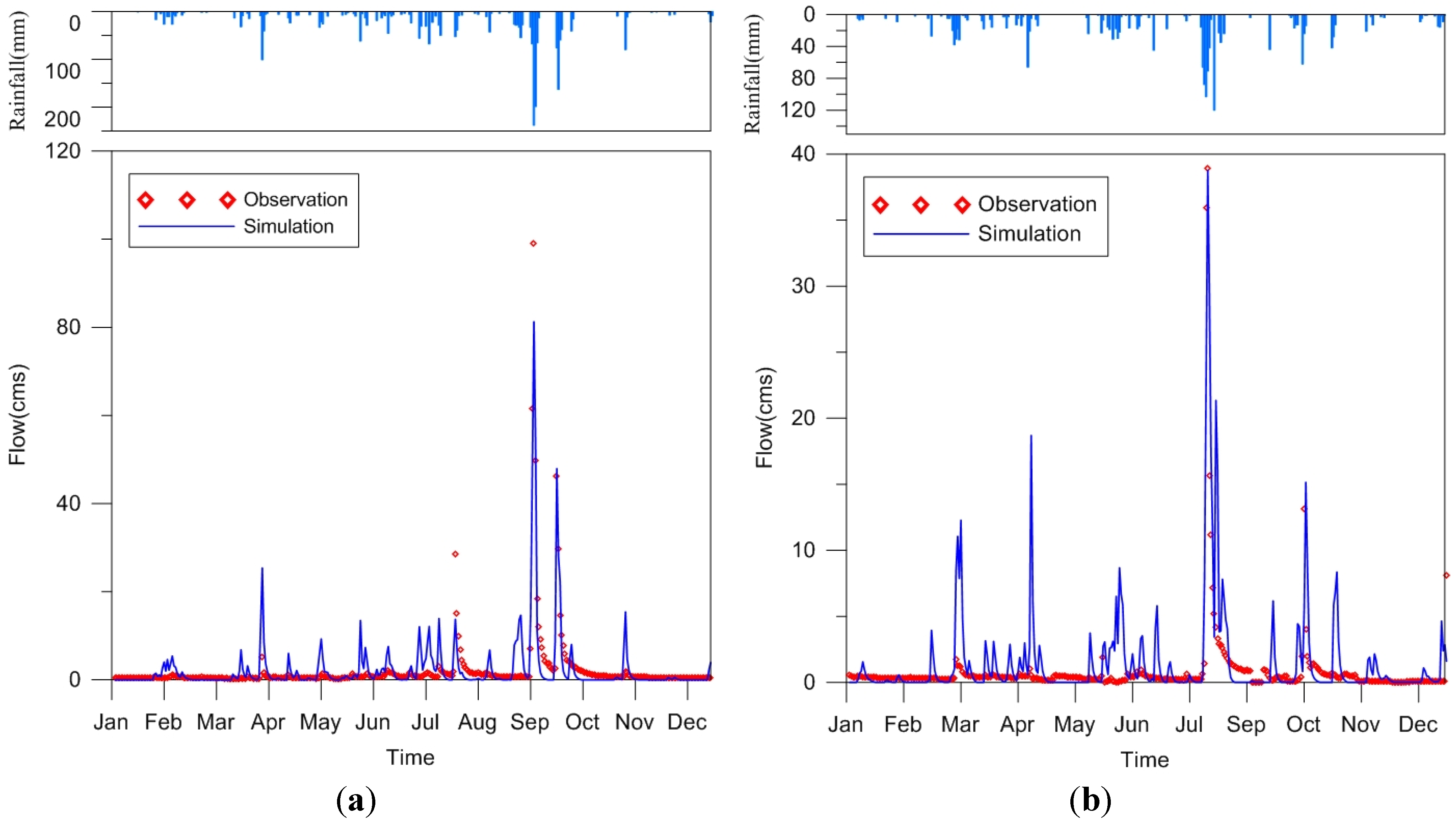
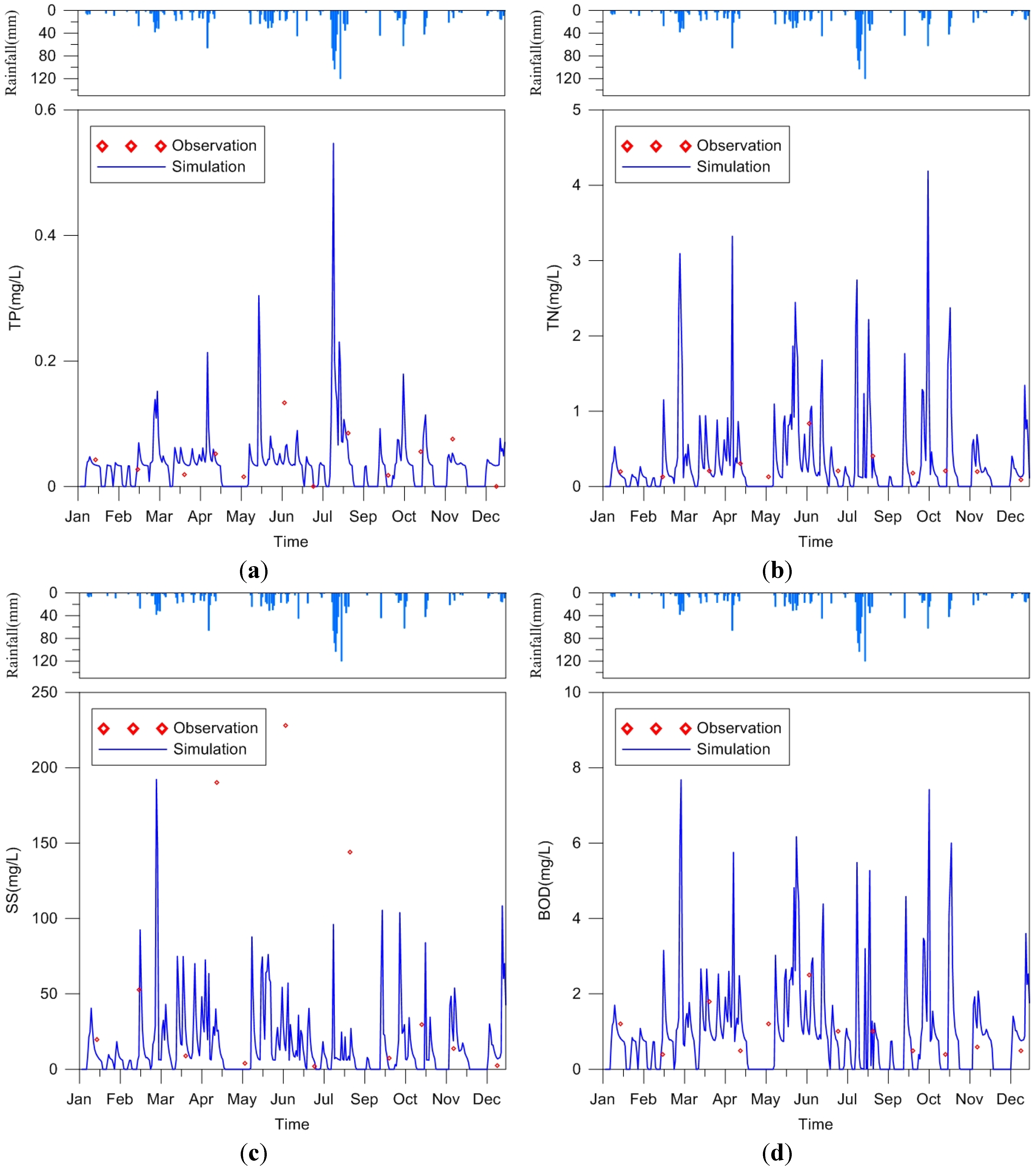
| Items | Flow | TP | TN | SS | BOD |
|---|---|---|---|---|---|
| Statistic Results | R2 | MAPE | |||
| Calibration | 0.79 | 25.18% | 12.34% | 32.85% | 29.2% |
| Verification | 0.67 | 25.21% | 0.74% | 33.14% | 37.5% |
| Model Parameter | Verified Value | Suggested Range * |
|---|---|---|
| Manning coefficient for pervious land (Np) | 0.8 | 0.06–0.8 |
| Manning coefficient for impervious land (Ni) | 0.3 | 0.1–0.3 |
| Depression depth for pervious land (Dp) | 0.012 | 0.011–0.024 |
| Depression depth for impervious land (Di) | 0.05 | 0.05–0.1 |
| Coefficient of roughness for open channel (R) | 0.1 | 0.04–0.1 |
| Water Quality and Selected Function | Land Use | |||
|---|---|---|---|---|
| Agriculture Land | Forest Land | Constructed Land | ||
| TP | Build up, c1 | POW *, 0.5 | POW, 0.35 | POW, 1.3 |
| Flush off, c1 | EMC, 0.3 | RC, 0.01 | EMC, 0.6 | |
| TN | Build up, c1 | POW, 0.4 | POW, 0.3 | POW, 0.6 |
| Flush off, c1 | EMC, 1 | RC, 0.4 | EMC, 1.5 | |
| SS | Build up, c1 | POW, 40 | POW, 30 | POW, 80 |
| Flush off, c1 | EMC, 50 | RC, 25 | EMC, 100 | |
| BOD | Build up, c1 | POW, 0.8 | POW, 0.5 | POW, 1.3 |
| Flush off, c1 | EMC, 6 | RC, 0.7 | EMC, 15 | |
3.2. Sensitivity Analysis of Model Parameters
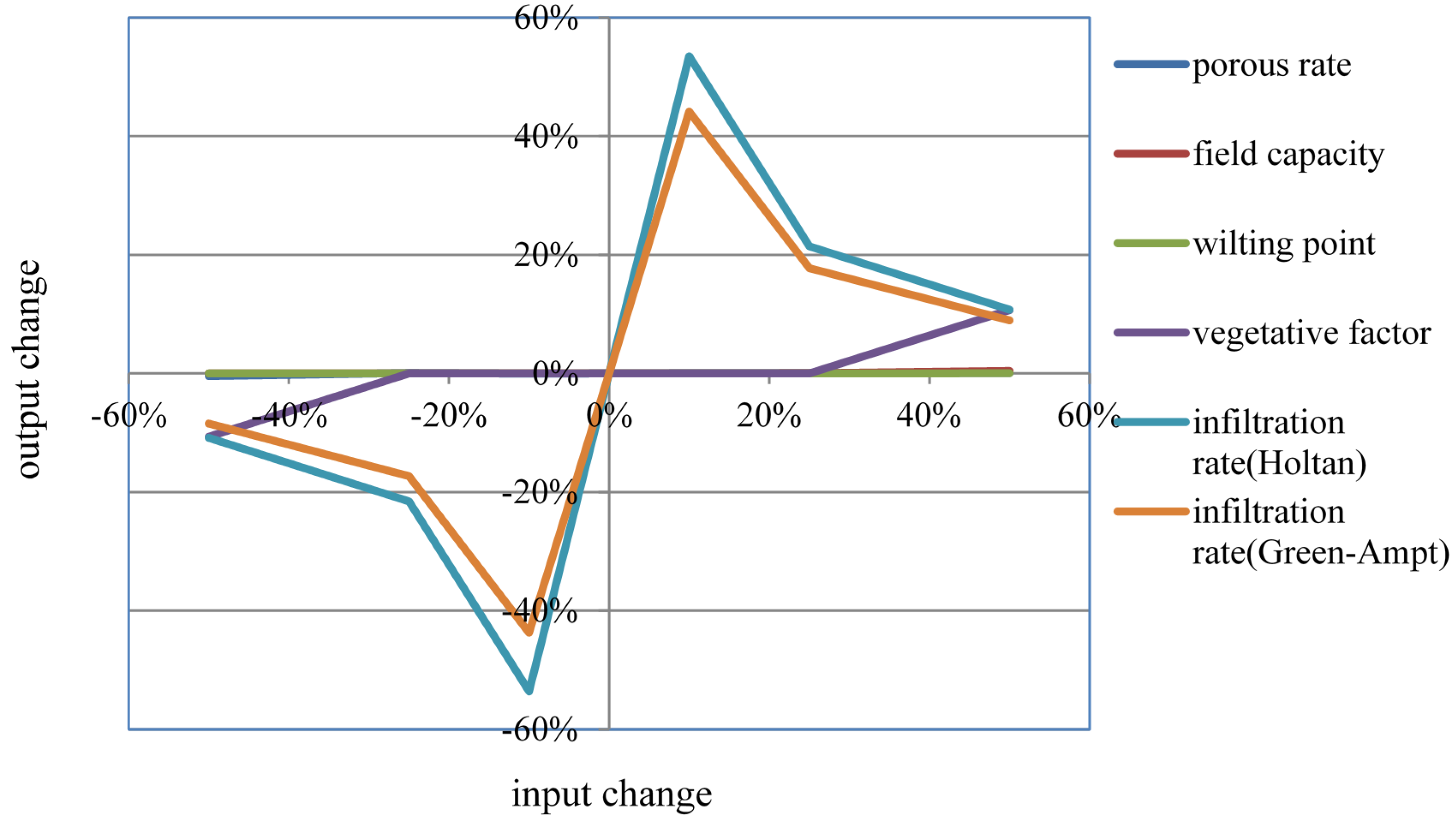
3.3. Effects of LID Types on Water Quality

3.4. Performance of LID Practices in Yuanshanyan Watershed
- Scenario 1: bioretention ponds for both open spaces and schools;
- Scenario 2: bioretention ponds for open spaces and pervious pavements for schools;
- Scenario 3: grass swales for open spaces and bioretention ponds for schools;
- Scenario 4: grass swales for open spaces and pervious pavements for schools.
| Site | LID Surface Area (ha) | Bioretention Ponds (Width and Length, m) | Pervious Pavement (Width and Length, m) | Grass Swale (Length, m) | Grass Swale (Width, m) |
|---|---|---|---|---|---|
| 1 | 6.20 | 249 | - | 522 | 119 |
| 2 | 16.10 | 401 | - | 1843 | 87 |
| 3 | 3.88 | 197 | - | 622 | 62 |
| 4 | 12.49 | 353 | - | 650 | 192 |
| 5 | 5.40 | 232 | - | 713 | 76 |
| 6 | 1.68 | 130 | - | 285 | 59 |
| 7 | 14.72 | 384 | - | 928 | 158 |
| 8 | 11.59 | 340 | - | 1111 | 104 |
| 9 | 12.51 | 354 | - | 865 | 144 |
| 10 | 13.77 | 371 | - | 1136 | 121 |
| 11 | 2.21 | 33 | 33 | ||
| 12 | 0.33 | 13 | 13 | - | - |
| 13 | 1.55 | 28 | 28 | - | - |
| 14 | 0.14 | 8 | 8 | - | - |
| 15 | 0.11 | 7 | 7 | - | - |
| 16 | 0.09 | 7 | 7 | - | - |
| 17 | 0.09 | 7 | 7 | - | - |
| 18 | 0.03 | 4 | 4 | - | - |
| 19 | 0.08 | 6 | 6 | - | - |
| 20 | 0.10 | 7 | 7 | - | - |
| 21 | 0.06 | 5 | 5 | - | - |
| 22 | 0.06 | 5 | 5 | - | - |
| 23 | 0.10 | 7 | 7 | - | - |
| 24 | 0.07 | 6 | 6 | - | - |
| 25 | 0.07 | 6 | 6 | - | - |

4. Conclusions
Acknowledgments
Author Contributions
Conflicts of Interest
References
- Low Impact Development (LID): A Literature Review; EPA-841-B-00–005; United States Environmental Protection Agency (USEPA): Washington, DC, USA, October 2000.
- Coffman, L.S. Low-impact development: An alternative stormwater management technology. In Handbook of Water Sensitive Planning and Design; France, R.L., Ed.; Lewis Publishers: Boca Raton, FL, USA, 2002; pp. 97–123. [Google Scholar]
- The SUDS Manual; Construction Industry Research and Information Association (CIRIA): London, UK, 2007.
- Demonstrating the Multiple Benefits of SuDS—A Business Case—Literature Review; CIRIA Research Project RP993; CIRIA: London, UK, 2013.
- Takahasi, Y.; Uitto, U.I. Evolution of river management in Japan: From focus on economic benefits to a comprehensive view. Global Environ. Change 2004, 14, 63–70. [Google Scholar] [CrossRef]
- Gilroy, K.L.; McCuen, R.H. Spatio-temporal effects of low impact development practices. J. Hydrol. 2009, 367, 228–236. [Google Scholar] [CrossRef]
- Jia, H.; Lu, Y.; Yu, S.L.; Chen, Y. Planning of LID–BMPs for urban runoff control: The case of Beijing Olympic Village. Sep. Purif. Technol. 2012, 84, 112–119. [Google Scholar] [CrossRef]
- Jia, H.; Yao, H.; Yu, S.L. Advances in LID BMPs research and practice for urban runoff control in China. Front. Environ. Sci. Eng. 2013, 7, 709–720. [Google Scholar] [CrossRef]
- Ahiablame, L.M.; Engel, B.A.; Chaubey, I. Effectiveness of low impact development practices: Literature review and suggestions for future research. Water Air Soil Pollut. 2012, 223, 4253–4273. [Google Scholar] [CrossRef]
- Doubleday, G.; Sebastian, A.; Luttenschlager, T.; Bedient, P.B. Modeling hydrologic benefits of low impact development: A distributed hydrologic model of the Woodlands, Texas. J. Am. Water Resour. Assoc. 2013, 49, 1444–1455. [Google Scholar] [CrossRef]
- Elliott, A.H.; Trowsdale, S.A. A review of models for low impact urban stormwater drainage. Environ. Model. Softw. 2007, 22, 394–405. [Google Scholar] [CrossRef]
- SUSTAIN—A Framework for Placement of Best Management Practices in Urban Watersheds to Protect Water Quality; EPA/600/R-09/095; USEPA: Washington, DC, USA, September 2009.
- Report on Enhanced Framework (SUSTAIN) and Field Applications for Placement of BMPs in Urban Watersheds; EPA 600/R-11/144; USEPA: Washington, DC, USA, November 2011.
- Lee, J.G.; Selvakumar, A.; Alvi, K.; Riverson, J.; Zhen, J.X.; Shoemaker, L.; Lai, F. A watershed-scale design optimization model for stormwater best management practices. Environ. Model. Softw. 2012, 37, 6–18. [Google Scholar] [CrossRef]
- Zhang, G.; Hamlett, J.M.; Reed, P.; Tang, Y. Multi-objective optimization of low impact development designs in an urbanizing watershed. Open J. Optim. 2013, 2, 95–108. [Google Scholar] [CrossRef]
- Baek, S.S.; Choi, D.H.; Jung, J.W.; Yoon, K.S.; Cho, K.H. Evaluation of a hydrology and run-off BMP model in SUSTAIN on a commercial area and a public park in South Korea. Desalin. Water Treat. 2014. [Google Scholar] [CrossRef]
- Saravanapavan, T.; Zhang, G.; Voorhees, M. Sustainability through optimization: The future of watershed management. Appl. Mech. Mater. 2013, 260–261, 876–881. [Google Scholar]
- Application Guide for Hydrological Simulation Program—FORTRAN (HSPF); EPA-600/3-84-065; USEPA: Washington, DC, USA, 1984.
- Rossman, L.A. Storm Water Management Model User’s Manual Version 5.0; EPA/600/R-05/040; USEPA: Washington, DC, USA, June 2007.
© 2014 by the authors; licensee MDPI, Basel, Switzerland. This article is an open access article distributed under the terms and conditions of the Creative Commons Attribution license (http://creativecommons.org/licenses/by/4.0/).
Share and Cite
Chen, C.-F.; Sheng, M.-Y.; Chang, C.-L.; Kang, S.-F.; Lin, J.-Y. Application of the SUSTAIN Model to a Watershed-Scale Case for Water Quality Management. Water 2014, 6, 3575-3589. https://doi.org/10.3390/w6123575
Chen C-F, Sheng M-Y, Chang C-L, Kang S-F, Lin J-Y. Application of the SUSTAIN Model to a Watershed-Scale Case for Water Quality Management. Water. 2014; 6(12):3575-3589. https://doi.org/10.3390/w6123575
Chicago/Turabian StyleChen, Chi-Feng, Ming-Yang Sheng, Chia-Ling Chang, Shyh-Fang Kang, and Jen-Yang Lin. 2014. "Application of the SUSTAIN Model to a Watershed-Scale Case for Water Quality Management" Water 6, no. 12: 3575-3589. https://doi.org/10.3390/w6123575





